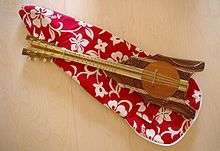Tahitian ukulele
The Tahitian ukulele (ʻukarere or Tahitian banjo) is a short-necked fretted lute with eight nylon strings in four doubled courses, native to Tahiti and played in other regions of Polynesia. This variant of the older Hawaiian ukulele is noted by a higher and thinner sound and an open back,[1] and is often strummed much faster.
 | |
| Classification | String instrument (plucked) |
|---|---|
| Related instruments | |
| ukulele, lute | |
The two middle courses are tuned an octave higher than they would be on a normal ukulele, and fishing line is used for the strings.
Construction


The Tahitian ukulele is significantly different from other ukuleles in that it does not have a hollow soundbox. The body (including the head and neck) is usually carved from a single piece of wood, with a wide conical hole bored through the middle. Alternatively Tahitian ukulele can be carved out of three pieces of wood with the sides being made from different woods, for decoration.
The tapered hole bored through the body is about 4 cm in diameter on the back; at the front it is about 10 cm in diameter. The hole is topped with a thin piece of wood, on which the bridge sits, so the instrument works rather like a wood-topped banjo. Indeed, some of these instruments are referred to as Tahitian banjos. The strings are usually made from light-gauge fishing line, usually green in colour (usually around 20 lb).
History
The instrument seems to be a relatively recent invention, popular in eastern Polynesia, particularly French Polynesia. The instrument is also used in the Marquesas Islands for pan-Pacific and Tahitian-based music,[2] and in the Cook Islands, where it became popular after its 1995 use in a music video by Tahitian band Te Ava Piti.[3]
Current luthiers
External links
References
- Pacific Arts: The Journal of the Pacific Arts Association. Pacific Arts Association Association. 2002. p. 25. Retrieved 6 March 2013. The accompanying musical instruments are the guitar and the Tahitian "banjo" ['ukarere], which is different from the Hawaiian 'ukulele in its higher sound and opening on the back of the instrument.
- Jane Freeman Moulin (1994). Music of the southern Marquesas Islands. Archive of Maori and Pacific Music, Dept. of Anthropology, University of Auckland. p. 44. ISBN 978-0-908689-29-3. Retrieved 6 March 2013.
- http://www.janesoceania.com/cookislands_music/index.htm